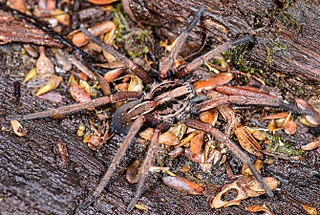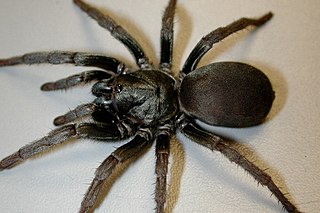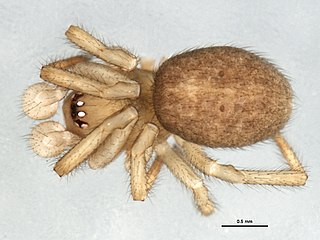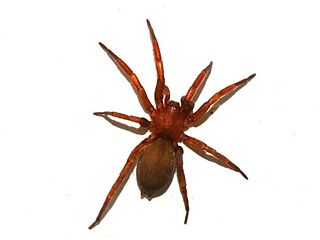
Miturgidae is a family of araneomorph spiders that includes nearly 170 species in 29 genera worldwide. First described by Eugène Simon in 1886, it has been substantially revised, and includes the previous family Zoridae as a synonym, and excludes the family Xenoctenidae. Several genera have also been removed, such as the large genus Cheiracanthium, which was transferred to the Cheiracanthiidae.

Ground spiders comprise Gnaphosidae, the seventh largest spider family with over 2,000 described species in over 100 genera distributed worldwide. There are 105 species known to central Europe, and common genera include Gnaphosa, Drassodes, Micaria, Cesonia, Zelotes and many others. They are closely related to Clubionidae. At present, no ground spiders are known to be seriously venomous to humans.

Linyphiidae, spiders commonly known as sheet weavers, or money spiders is a family of very small spiders comprising 4706 described species in 620 genera worldwide. This makes Linyphiidae the second largest family of spiders after the Salticidae. The family is poorly understood due to their small body size and wide distribution; new genera and species are still being discovered throughout the world. The newest such genus is Himalafurca from Nepal, formally described in April 2021 by Tanasevitch. Since it is so difficult to identify such tiny spiders, there are regular changes in taxonomy as species are combined or divided.

Tegenaria is a genus of fast-running funnel weavers that occupy much of the Northern Hemisphere except for Japan and Indonesia. It was first described by Pierre André Latreille in 1804, though many of its species have been moved elsewhere. The majority of these were moved to Eratigena, including the giant house spider and the hobo spider.

Dwarf sheet spiders (Hahniidae) is a family of araneomorph spiders, first described by Philipp Bertkau in 1878. Their bodies are about 2 millimetres (0.079 in) long, and they build extremely delicate webs in the form of a sheet. Unlike many spiders the web does not lead to a retreat. The silk used in these webs is so fine that they are difficult to spot unless they are coated with dew. They greatly favor locations near water or near moss, and are often found in leaf litter and detritus or on the leaves of shrubs and trees.

Zodarion is a genus of ant-eating spiders from the family Zodariidae. 169 species from Eurasia, North Africa and North America have been described as of November 2022.
Pimoidae is a small family of araneomorph spiders first described by J. Wunderlich in 1986. As re-circumscribed in 2021, it is monophyletic, and contained 85 species in two genera. It is closely related to the Linyphiidae, and is sometimes treated as synonymous with that family.

Nemesiidae is a family of mygalomorph spiders first described by Eugène Simon in 1889, and raised to family status in 1985. Before becoming its own family, it was considered part of "Dipluridae". The family is sometimes referred to as wishbone spiders due to the shape of their burrows.

Drassodes is a genus of ground spiders that was first described by Niklas Westring in 1851. They are brown, gray, and red spiders that live under rocks or bark in mostly dry habitats, and are generally 3.8 to 11.6 millimetres long, but can reach up to 20 millimetres (0.79 in) in length.

Dysdera is a genus of woodlouse hunting spiders that was first described by Pierre André Latreille in 1804. They originated from Central Asia to Central Europe.

Zelotes is a genus of ground spiders that was first described by J. Gistel in 1848.

Gnaphosa is a genus of ground spiders that was first described by Pierre André Latreille in 1804. They all have a serrated keel on the retromargin of each chelicera.

Robertus is a genus of comb-footed spiders that was first described by Octavius Pickard-Cambridge in 1879. It is considered a senior synonym of Garritus.
Harpactocrates is a genus of woodlouse hunting spiders that was first described by Eugène Simon in 1914.

Haplodrassus is a genus of ground spiders that was first described by R. V. Chamberlin in 1922. They range from 3 to 10 millimetres. H. signifer is the most widespread species, found across North America except for Alaska and northern Canada.

Centromerus is a genus of dwarf spiders that was first described by David B. Hirst in 1886.
Panamomops is a genus of dwarf spiders that was first described by Eugène Louis Simon in 1884.

Silometopus is a genus of sheet weavers that was first described by Eugène Louis Simon in 1926.














